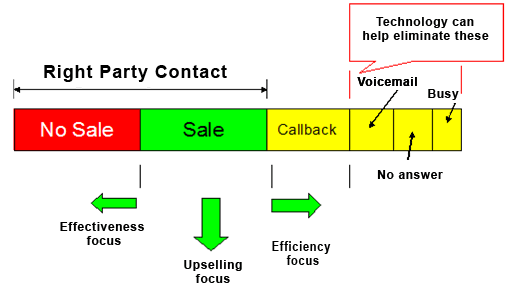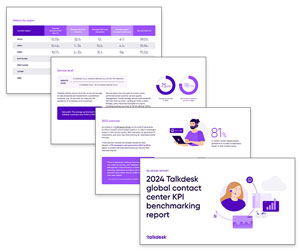Outbound KPIs
Typically, the primary measure that most outbound centres use as a key performance indicator is the amount of time an agent spends on the phone.
The conventional wisdom is that a good calling list results in more contacts being made, which will increase agent time on the phone. In part it is true that outbound calling is a numbers game, but it is also about timing.
Right-Party Contact
A more meaningful measure to focus on is ‘right-party contact’ as this really reflects the number of genuine contact opportunities that an outbound agent actually has to talk to a decision maker. To illustrate this point, think of all the possible outcomes of a call.
Firstly, you have all the reasons why you do not get to speak to anyone – the line is busy, there is no reply or you get a voice messaging system where all you can do is leave a message. Secondly, you get to speak to someone, but they are not the person that you are targeting.
Whilst you can glean some information from these contacts, for example when it is likely to be a good time to call, they do not represent the true opportunity. It is only when you get to speak to the ‘right-party contact’ that you get a real chance to transact.
To make your outbound centre more efficient, you therefore need to consider ways in which you can drive up the proportion of right-party contacts. As indicated before, technology can help you to eliminate the non-contacts, however, these outbound dialling systems do not address the root cause of contacting the right party. Here you need some business intelligence about who the decision maker is and when is the right time to call.

The first of these is down to the quality of your marketing information and how up to date it is as people change roles, move company, etc. The timeliness of a contact is, however, something that you can directly measure and therefore influence.
A simple test is to get an agent to indicate on a call log when they got to speak to the decision maker and the time of the call. You can then look at each hour of the day for a particular agent and plot the number of right-party contacts for that hour. You may be surprised at the results – and often there are some simple home truths, like don’t call catering managers at lunchtime, and don’t call mums between 3pm and 4pm when they are on the school run! These indicators will, of course, be different depending on whether you are contacting businesses or consumers.
Right-party contact can be measured in a number of ways. However, if you want to ensure that you measure the effectiveness of your campaign and the accuracy of the database from which you extracted the contact, then best practice indicates that you should measure the net contact figure (where a negative result is only when the contact was not established, and a positive result is where contact was established regardless of the outcome of the call).
Historically the only measure in an outbound operation was the amount of time each agent spent on the phone. As operations and systems have become more sophisticated, so have the measures that are able to be deployed.
Key Performance Indicators
Key Performance Indicators for a successful outbound campaign can now include:
- Net contact score
- Adherence to dialler schedule
- Conversion rate
- Added value rating
Contributors
Paul Weald
Author: Jonty Pearce
Published On: 27th Mar 2010 - Last modified: 19th Sep 2019
Read more about - Call Centre Management, Key Performance Indicators (KPIs), Outbound dialling, Outbound Dialling Guide




































